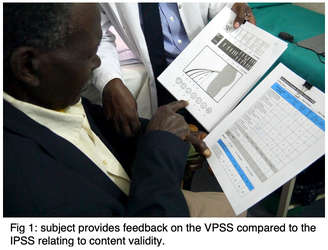Back
Poster, Podium & Video Sessions
Moderated Poster
MP30: Global Health/Humanitarian
MP30-16: The Burden of Bladder Outlet Obstruction in Men in Rural Uganda: A Cross Sectional Survey and Further Validation of the Visual Prostate Symptom Score (VPSS)
Saturday, May 14, 2022
1:00 PM – 2:15 PM
Location: Room 222
Lynn stothers*, Andrew Macnab, vancouver, Canada
- LS
Lynn Stothers, MD
University of California Los Angeles
Poster Presenter(s)
Introduction: Bladder outlet obstruction (BOO) is estimated to affect 1.1 billion men worldwide. A considerable decrease in morbidity and mortality from BOO has been achieved in regions of the world with higher income through improvements in surgical and medical management. Barriers to clinical assessment and education about BOO have included literacy and regional language variations.
Epidemiological studies demonstrating the incidence and severity of BOO in low- and middle-income countries (LMIC’s) are based on estimates.
Aim: to 1) to conduct a community-based quantitative assessment of the burden of BOO in a rural African community, 2) further validate the Visual Prostate Symptom Score (VPSS) against the International Prostate Symptom Score (IPSS).
Methods: We used two recruitment strategies: radio phone-in talk shows to promote clinic attendance, and community outreach travel to survey patients in rural areas. The VPSS was compared to the IPSS: men completed the VPSS and IPSS without assistance, then the VPSS and IPSS with assistance in their native language. They described their understanding of pictograph meaning (face validity), related usefulness of each pictogram, and provided feedback to improve content validity.
Results: A cross-sectional survey in rural Uganda comparing the burden of disease due to LUTS in men > 50 years of age living in the community (N = 238) with a second cohort seeking treatment at a medical clinic (N = 177). Based on the IPSS moderate and severe symptoms were seen in 31% and 12% for those in the community versus 55 and 30% seeking clinic attention respectively (p < 0.05). In N=136 completing the IPSS VPSS validation 90% had inherent recognition of the weak stream pictograph and only 42% for the nocturia images.
Conclusions: Our data showed that the frequency and negative impact of LUTS are high in the community. Whilst the drugs recommended were available at local clinics, educational barriers, and limited knowledge about the effectiveness of treatment are greater than previously recognized. Health education about BOO was welcomed at workshops to debrief participants. General content validity of the VPSS was high but the nocturia pictograph could be further developed including the size of images due to reduced visual health in the population.
Source of Funding: Grand Challenges Canada

Epidemiological studies demonstrating the incidence and severity of BOO in low- and middle-income countries (LMIC’s) are based on estimates.
Aim: to 1) to conduct a community-based quantitative assessment of the burden of BOO in a rural African community, 2) further validate the Visual Prostate Symptom Score (VPSS) against the International Prostate Symptom Score (IPSS).
Methods: We used two recruitment strategies: radio phone-in talk shows to promote clinic attendance, and community outreach travel to survey patients in rural areas. The VPSS was compared to the IPSS: men completed the VPSS and IPSS without assistance, then the VPSS and IPSS with assistance in their native language. They described their understanding of pictograph meaning (face validity), related usefulness of each pictogram, and provided feedback to improve content validity.
Results: A cross-sectional survey in rural Uganda comparing the burden of disease due to LUTS in men > 50 years of age living in the community (N = 238) with a second cohort seeking treatment at a medical clinic (N = 177). Based on the IPSS moderate and severe symptoms were seen in 31% and 12% for those in the community versus 55 and 30% seeking clinic attention respectively (p < 0.05). In N=136 completing the IPSS VPSS validation 90% had inherent recognition of the weak stream pictograph and only 42% for the nocturia images.
Conclusions: Our data showed that the frequency and negative impact of LUTS are high in the community. Whilst the drugs recommended were available at local clinics, educational barriers, and limited knowledge about the effectiveness of treatment are greater than previously recognized. Health education about BOO was welcomed at workshops to debrief participants. General content validity of the VPSS was high but the nocturia pictograph could be further developed including the size of images due to reduced visual health in the population.
Source of Funding: Grand Challenges Canada


.jpg)
.jpg)